How to Fire a Client Without Burning Bridges
Not every client is a dream client—and sometimes, the best move is to walk away. Here’s how to fire a client without the drama (and with your sanity intact).
-min.png?width=100&name=image%20(21)-min.png)
Gabriela Łaba

Contents
- Is it the right time to fire a client? Signs to watch for
- What to do before firing a client
- How to fire a client professionally
- How to fire a client: Scripts and templates
- What not to do when firing a client
- Life after firing a client
- Walking away, the right way
Ready to book more meetings?
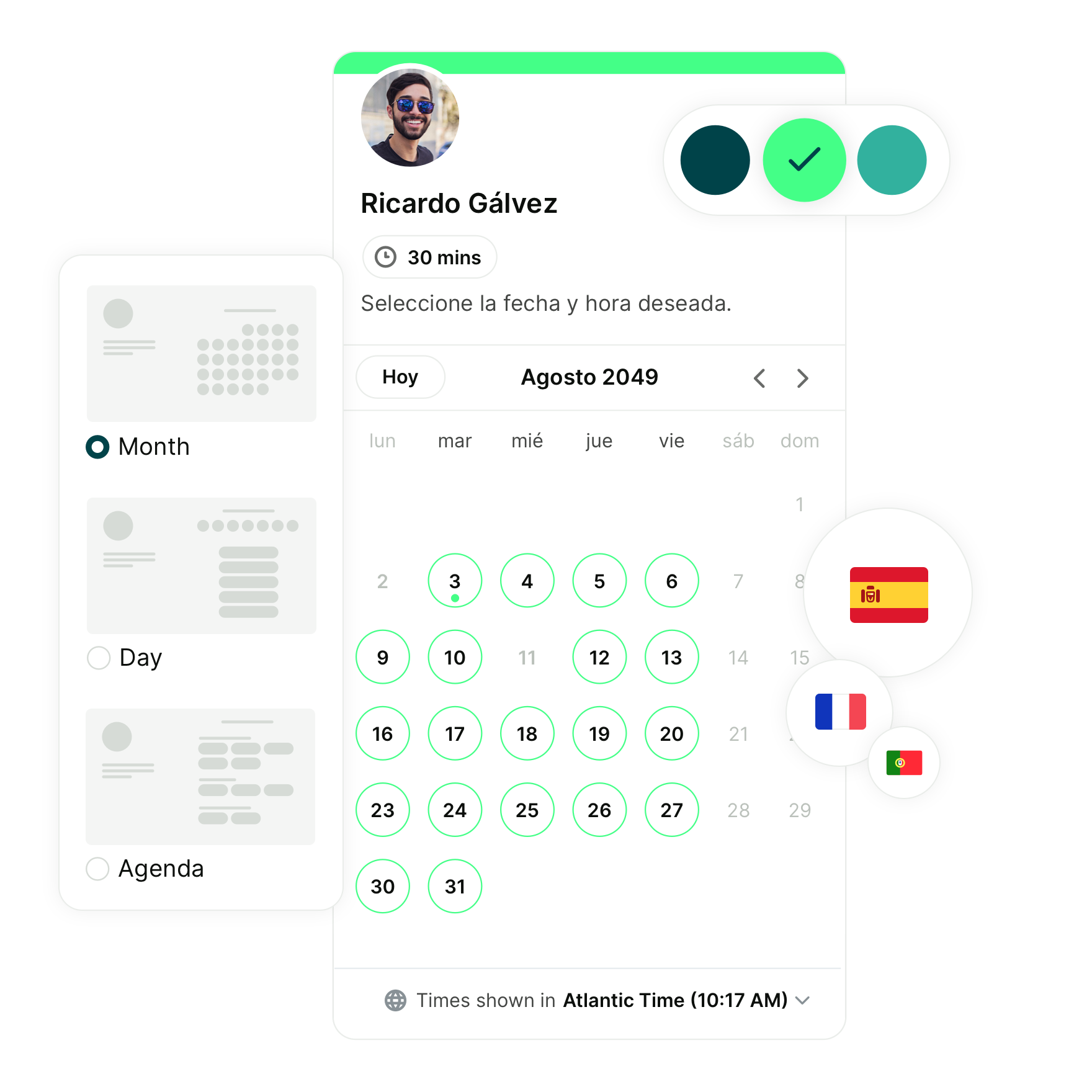
At some point, every freelancer, small business owner, or service provider faces this uncomfortable thought: “I think I need to fire this client.” Cue the anxiety. 😬
Maybe the client drains your time, ignores boundaries, doesn’t pay on time, or just makes your work life harder than it needs to be. Whatever the reason, ending a client relationship can feel risky, awkward, and downright stressful.
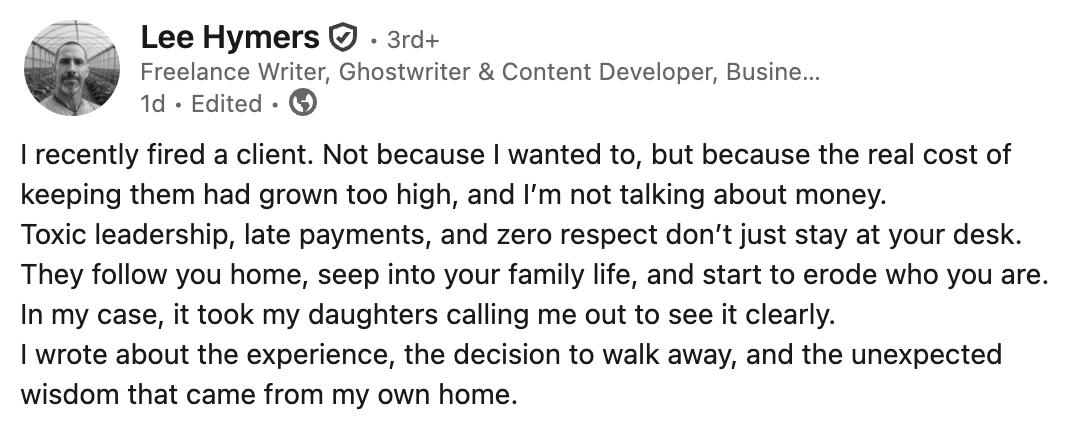
(Source)
But here’s the good news: when handled the right way, firing a client can actually strengthen your business. It can protect your energy, your reputation, and make space for better-fit clients who respect your work.
In this guide, we’ll walk through:
- How to recognize when it’s time to let a client go
- What to do before you make the move
- How to break the news professionally (with templates!)
- What not to do if you want to protect your business
- And how to bounce back stronger—with clearer boundaries and better clients
It’s not easy, but it doesn’t have to be messy. Let’s walk through it together.
Is it the right time to fire a client? Signs to watch for
Not sure if you’re overthinking things—or if it’s truly time to part ways with a client? Here are some clear warning signs to watch out for. If one (or more) of these hits a bit too close to home, it might be time to move on.
- They’re disrespectful or abusive: Verbal abuse, condescending behavior, or toxic communication should never be tolerated. Remember, no client is worth your emotional well-being.
- Scope creep with no additional pay: When the client constantly asks for “just one more thing” that’s outside the original agreement—without offering to pay for the extra time—you’re essentially working for free.
- They don’t pay on time (or at all): Payment delays create stress and instability in your business. If you’re spending more time chasing unpaid invoices than delivering work, that’s a huge red flag.
- You dread working with them: If their name in your inbox makes your heart sink—or if you procrastinate just to avoid dealing with them—it’s probably affecting your entire workflow.
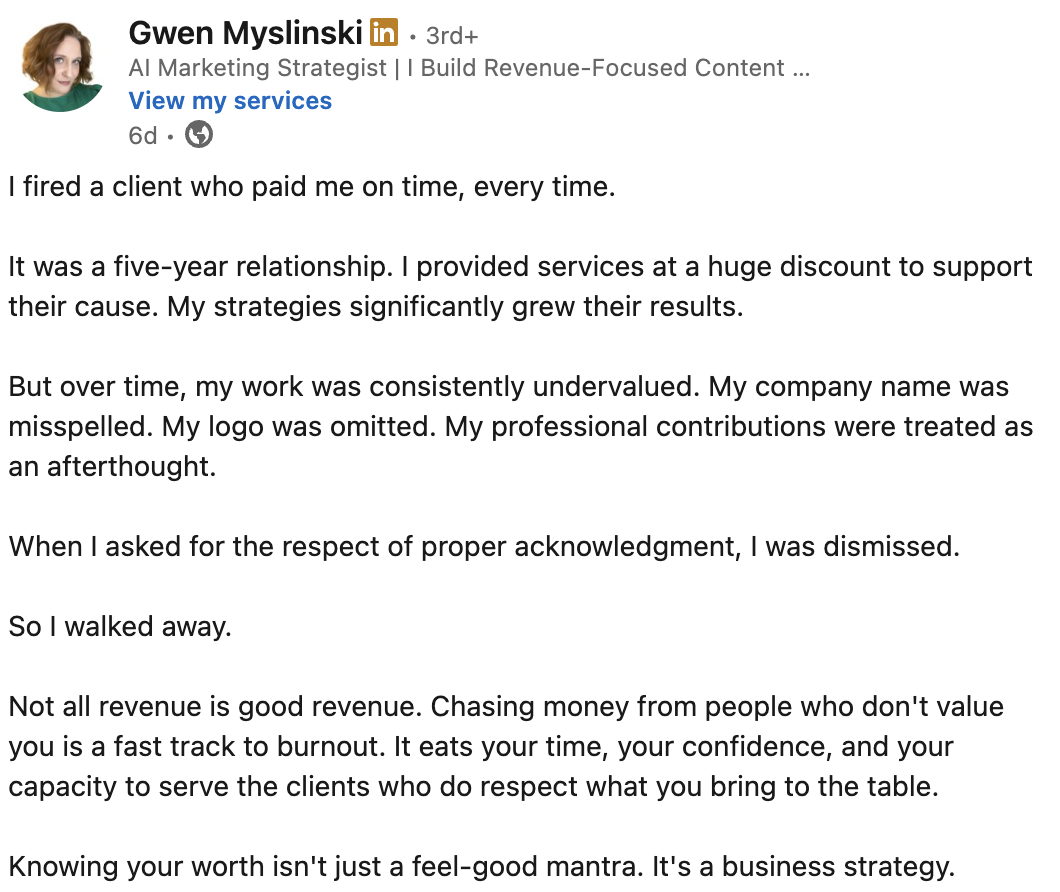
(Source)
- They’re costing you more than they’re worth: Look at the numbers. Are they a low-paying, high-maintenance client? Consider what else you could be doing with the time, energy, and mental space they take up.
- They ignore your boundaries: Clients who expect 24/7 access, demand instant replies, or contact you through every app under the sun? That’s a sure-fire recipe for burnout.
- There’s a value mismatch: If your client’s business practices or ethics make you uncomfortable, that’s a legitimate reason to walk away.
- You’ve simply outgrown the relationship: As your skills, services, or business model evolve, some clients may no longer be the right fit—and that’s okay. Maybe you started out offering basic services and now specialize in something more advanced, or your ideal client has shifted. Letting go of mismatches makes space for the kind of work (and people) that align with where you're headed!
|
💡 Pro tip : Before you make the final call, ask yourself: “Have I clearly communicated my concerns?” When you’re trying to deal with a difficult client, remember—sometimes they don’t even realize they’re crossing a line, especially if you haven’t said anything directly. If you’ve been suffering in silence, it’s worth having an honest conversation first. But if you’ve already tried that and nothing’s changed? Then yeah, it might be time to call it. |
What to do before firing a client
You’ve spotted the red flags, and you’re leaning toward ending the relationship—but don’t hit “send” on that final message just yet. Firing a client is a big move, and there are a few steps you need to take to protect yourself, your business, and your reputation.
Review your contract
Before sending that email or making the call, double-check your agreement. Are there notice periods, refund clauses, or termination conditions? This will shape how you exit the relationship without violating terms or leaving loose ends.
Document the issues/reasons for leaving
Don’t rely on memory! Save email threads, note dates of missed payments, and log changes in scope. If you’ve had difficult conversations over the phone, follow up with a written summary. This protects you and ensures clarity if anything gets questioned later.
Try having a reset conversation
As we briefly mentioned above, a direct conversation can put things back on track—especially if the client isn’t aware of the impact they’re having!
You can say: “I’ve noticed a few patterns that are affecting our work together. I’d love to talk about how we can adjust things going forward.”
This gives them a chance to improve, and it gives you peace of mind knowing you gave it one last honest shot before walking away.
Make a plan to transition out smoothly
Start thinking about what a clean exit would look like. Will you finish the current milestone? Deliver final files? Provide handover notes? You don’t need to present this plan yet, but having it ready helps reduce anxiety and boost your professionalism when the time comes.
Assess the financial impact
Ah, money—this part might be the hardest. If this client represents a big chunk of your income, firing them might feel risky. So ask yourself:
- Can I afford to lose this income right now?
- Do I have any solid leads in my pipeline?
- Can I hold off a few weeks while I secure a replacement?
You might not fire them today, but if the stress is building, start prepping for an exit. That might mean actively looking for a new client or reducing reliance on this one over time.
|
💡 Pro tip: Ask yourself which stress feels heavier—losing the money or keeping the client? That’s your answer. |
When you’re starting a business, you’re thinking—I need the money, I need the money. I can tell you without a doubt, let that money go. Never think for a moment that if you lose that customer, you will not get another.”
- Corine La Font, Public Relations and Communication Consultant
How to fire a client professionally
Deciding to end a client relationship is one thing—actually doing it is another. It can feel uncomfortable, especially if you’ve never done it before.
But with the right approach, you can part ways respectfully and professionally, without burning bridges or second-guessing yourself. Here’s how to fire a client with clarity, confidence, and grace. 🎉
Choose the right medium: Email or call?
Before you reach out, think about how you want to have the conversation. Some situations call for an email, while others deserve a more personal touch.
Ask yourself: Would this be better as a written message I can carefully craft? Or does it feel more respectful to talk it out live?
Either way, you’ll always want to follow up with an email. Even if you discuss it in person or over the phone, it’s important to have the termination clearly documented in writing. For some situations, an email alone is fine. For others—especially more emotional or long-term relationships—it might be a combination of both: a call to talk it through, and an email to confirm everything in writing.
Email pros ✅ |
Email cons ❌ |
|
|
Phone/video call pros ✅ |
Phone/video call cons ❌ |
|
|
Bottom line: there’s no “right” answer—just what feels most appropriate for the situation and the relationship.
Be direct, polite, and clear
When you’re ready to deliver the message, clarity is everything. You don’t need to go into a long explanation or list every issue—just be honest, respectful, and to the point.
This isn’t about blaming anyone or rehashing everything that went wrong. It’s about setting a clear boundary and moving forward with integrity.
You could say:
- "I’ve appreciated the opportunity to work together, but after evaluating my current workload and focus, I’ve decided I’m no longer able to continue working together."
- "I don’t think I’m the right fit for what you need moving forward, and I want to be respectful of your time and goals."
- "I’ve realized that our working styles aren’t the best fit, and I think you’d be better served by someone who’s a better match for your needs."
You can be polite without being overly apologetic. Remember, you’re not doing something wrong—you’re doing what’s right for your business!
Offer a transition or referral when possible
If you can, help them land on their feet. Offering a clean transition or pointing them to someone else is a small gesture that goes a long way.
This might mean finishing a final task, sending handoff notes, or referring them to another provider who may be a better fit. You don’t have to do any of this, but if the situation allows, it leaves things on a positive note!
You might say:
- "I’ll deliver any outstanding work by [date], and I’m happy to help with a handoff if needed."
- "If you’re open to it, I can suggest a few people in my network who might be a good fit for what you’re looking for."
It’s professional, helpful, and keeps the relationship intact—even if it’s ending.
Leave the door open (if appropriate)
Not every breakup has to be permanent. Sometimes, it’s just the wrong time, scope, or fit, right now.
If you’d consider working with them again under different circumstances, it’s okay to say so. Just make sure you're clear about what would need to change.
For example:
- "I’d be happy to reconnect down the line if our needs align again."
- “If your future projects are a better fit for my bandwidth and skill set, I’d love to explore that with you."
How to fire a client: Scripts and templates
Not sure how to fire a client without making things weird? You’re not alone. Having a script or template can take the pressure off and help you focus on how you want to come across—calm, professional, and in control.
Below are a mix of email templates and conversation starters you can use or modify, depending on your situation and industry.
General email templates for firing a client
Template 1: Polite and straightforward
Subject: Project closeout and next steps
Hi [Client name],
After reviewing my current commitments and business priorities, I’ve decided to step away from our engagement. I want to thank you for the opportunity to work together over the past [time period].
I’ll make sure all outstanding work is completed, including:
- [Deliverable 1]
- [Deliverable 2]
- [Deliverable 3]
These will be delivered by [end date], and I’m happy to assist with a smooth handoff if needed.
I truly appreciate your trust and collaboration and wish you all the best moving forward.
Warmly,
[Your name]
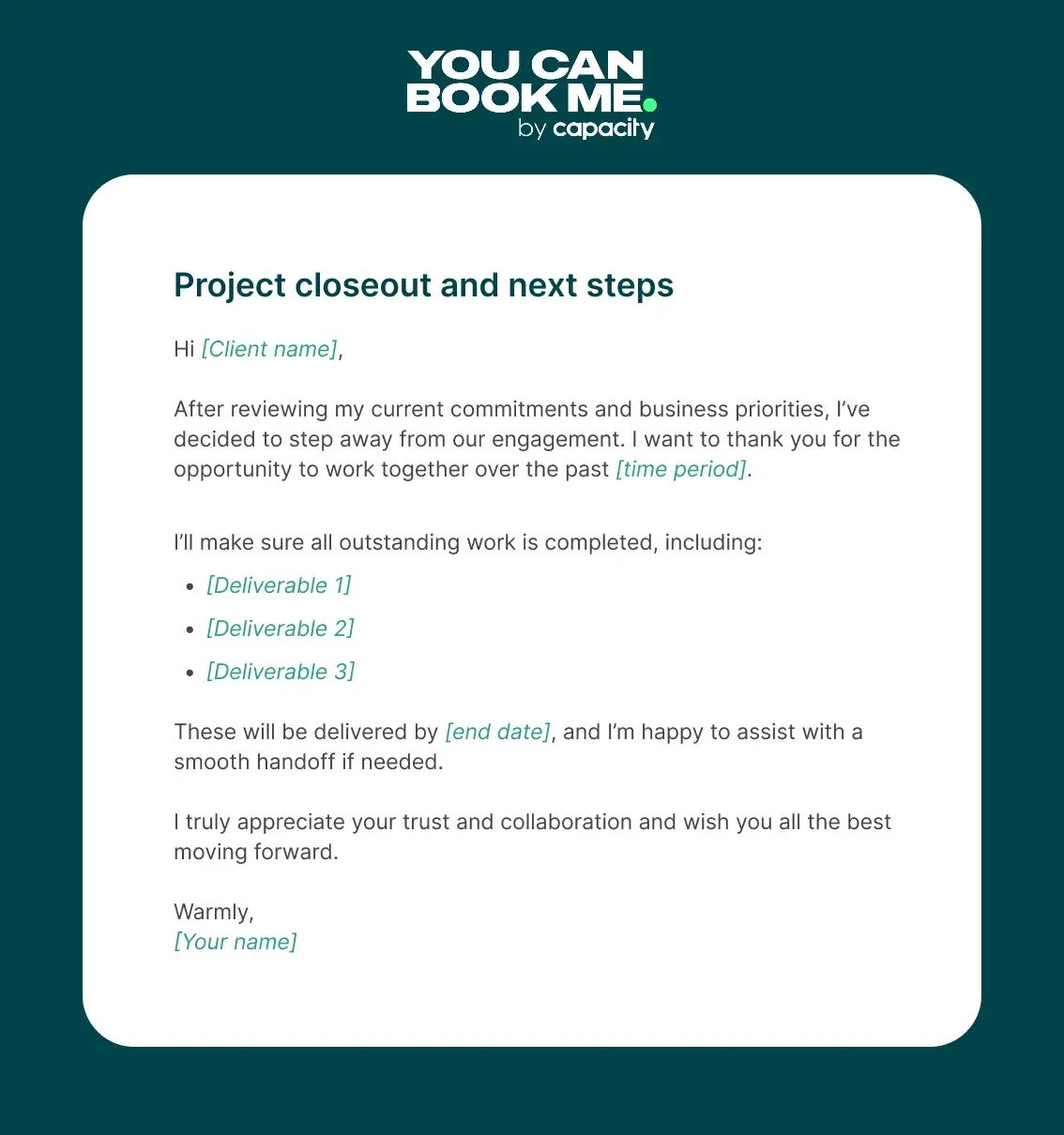
Template 2: Not a fit anymore
Subject: Transitioning our work together
Hi [Client name],
I’ve taken some time to reflect on our work together, and I’ve realized our current arrangement is no longer the best fit. I want to be transparent and let you know that I’ll be stepping away from the project.
My priority is to make this transition as smooth as possible. I’m happy to complete any pending tasks by [date], and if it’s helpful, I can recommend someone in my network who may be a strong fit for your next steps.
If you’d like to talk this through in more detail, I’m open to setting up a call. I just wanted to give you a heads-up so you can start planning accordingly.
Thank you again for the opportunity to collaborate. I’ve truly appreciated working with you and wish you all the best moving forward.
Best,
[Your name]
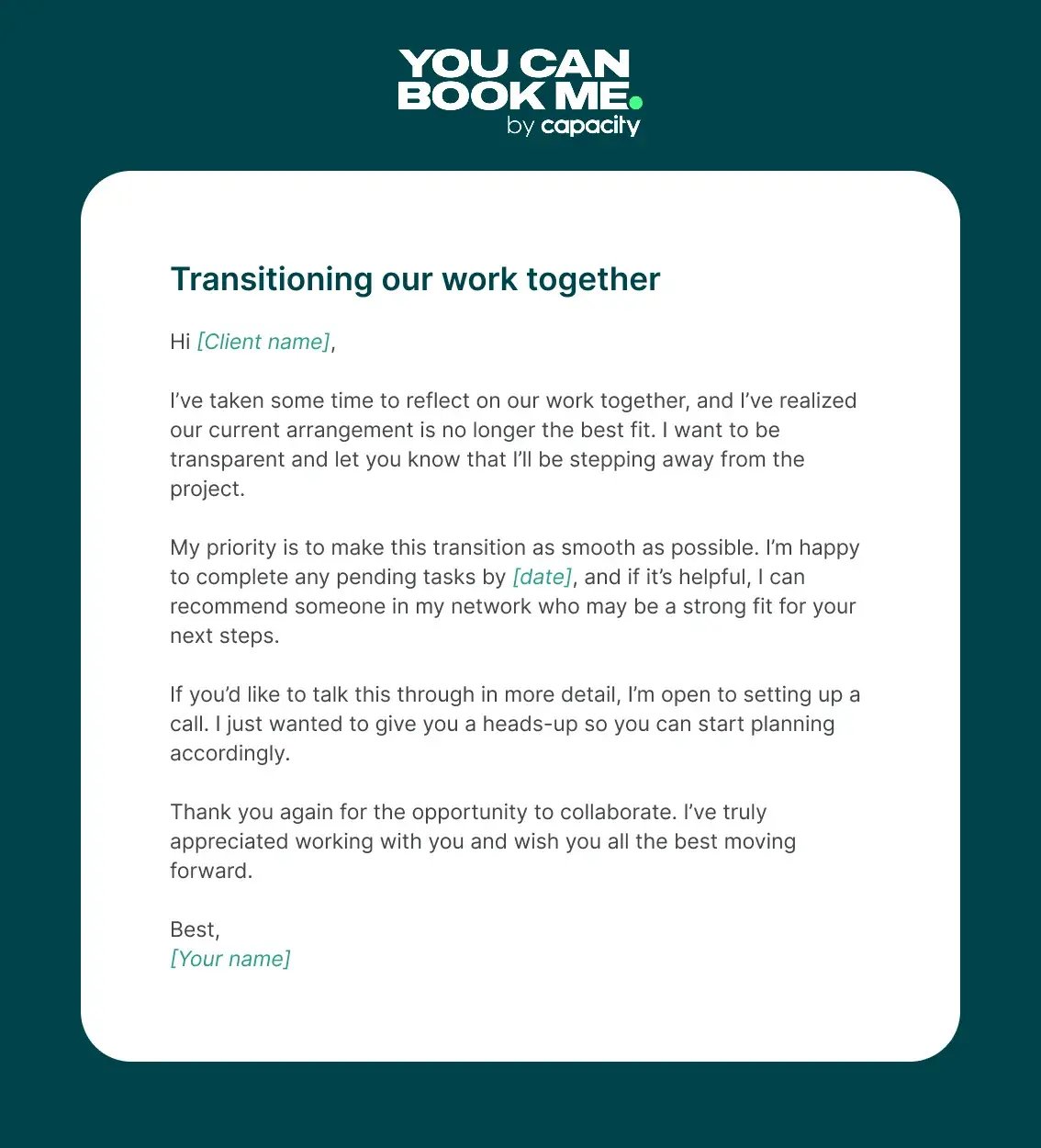
Template 3: Changing business direction
Subject: Wrapping up services and what’s next
Hi [Client name],
I wanted to let you know that I’m making some changes to my business and will no longer be offering [specific service]. Because of that, I’ll be wrapping up our engagement as of [date].
I’ll make sure all outstanding work is delivered and will send over anything you need for a smooth transition.
If it’s helpful, I can also recommend a few trusted professionals who are great at [specific service] and might be a good fit for your next steps.
Thanks so much for your support—I've really appreciated working with you and wish you all the best moving forward.
Best,
[Your name]
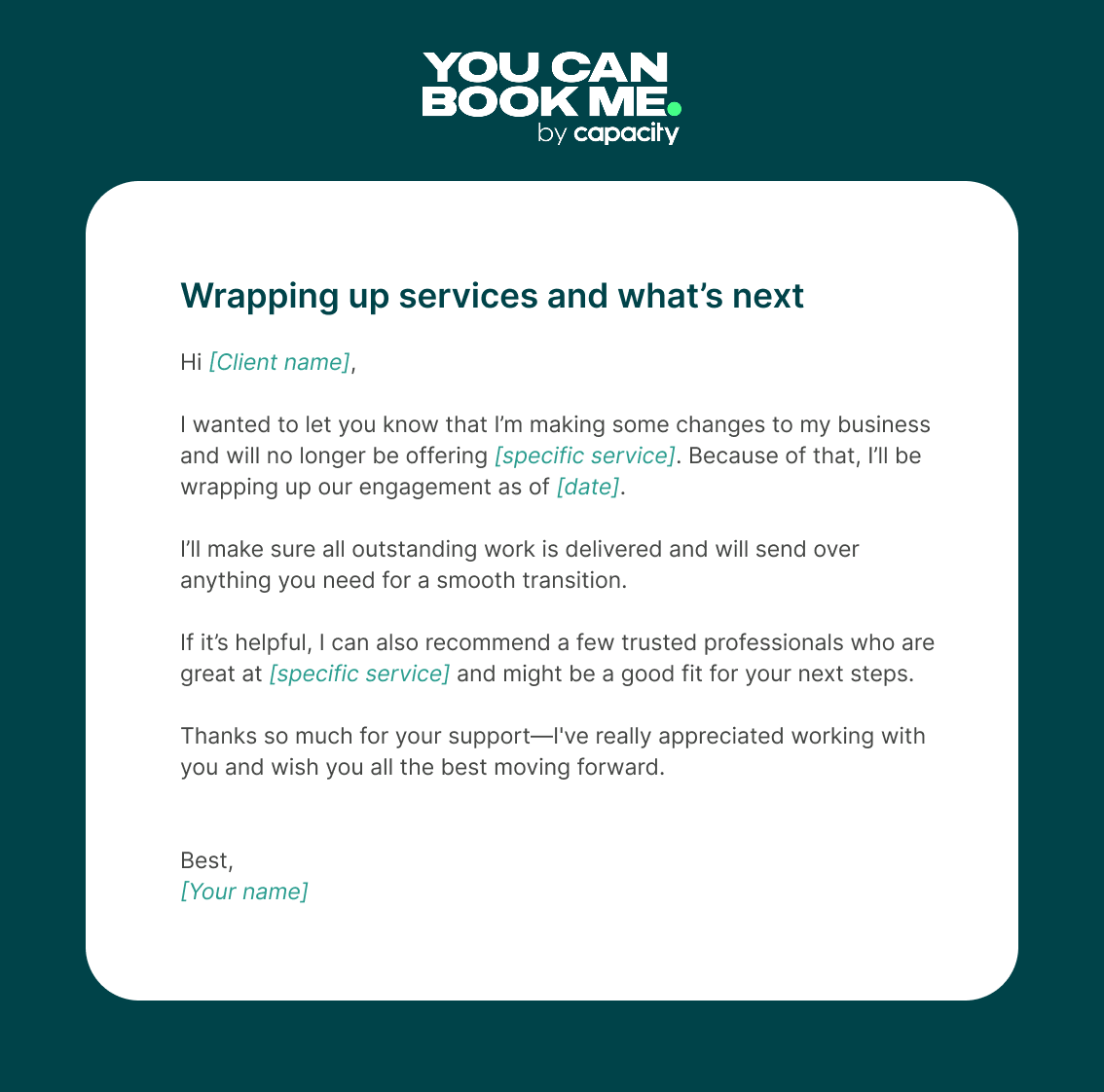
Template 4: Wrapping up after things didn’t click
Subject: Transitioning our work together
Hi [Client name],
I’ve really appreciated our recent conversations and the chance to check in about how things are going. After taking some time to reflect, I’ve decided it’s best for me to step back from our current work together.
I was hopeful that some adjustments might help us move forward, but it seems like we’re still not quite aligned—and that’s okay. I’d much rather pause here and leave things on good terms than continue in a way that doesn’t fully serve either of us.
I’ll make sure any remaining work is wrapped up by [end date], and I’m happy to help with anything you might need to transition smoothly.
Thank you again for the opportunity to work together—it truly means a lot. I’m wishing you the very best in what’s ahead.
Sincerely,
[Your name]

Bonus: Call/video script starter
Calls are dynamic and, unfortunately, can’t be templated as easily. But here’s an easy way to at least open the dialogue!
“Thank you for taking the time for this call. I wanted to talk about our work together—I’ve been doing some thinking, and I’ve realized that I’m not in the best position to continue supporting you moving forward. I want to make sure we transition everything smoothly, and I’m happy to walk through how that could look and answer any questions you may have.”
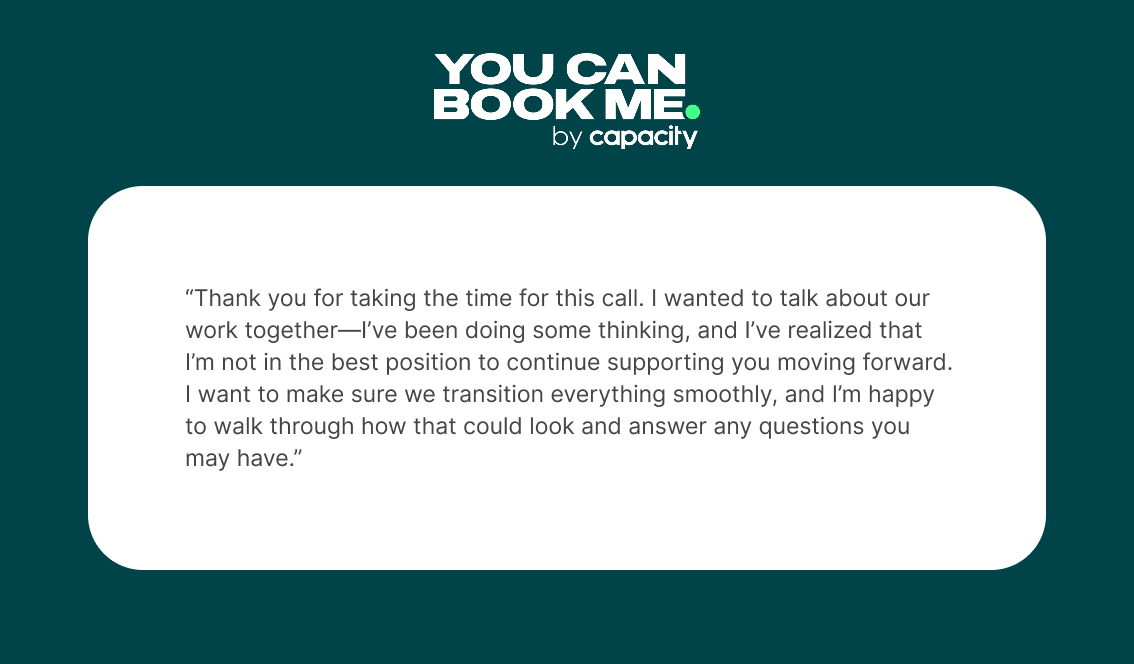
From there, you can move on to your reasons (as much or as little as you want to share) and any wrap-up or referral details.
Industry-specific templates for firing a client
Hair salon/stylist
Subject: Changes to my booking availability
Hi [Client name],
I wanted to reach out personally to let you know I’m making some changes to my schedule and client list, and as part of that shift, I won’t be able to offer future appointments moving forward.
This has been a thoughtful decision based on how I’m restructuring my availability and services, and while it’s not easy to say goodbye, I want to thank you sincerely for the opportunity to work together. I truly appreciate the trust you’ve placed in me.
If you have any questions or need anything as you transition to a new stylist, I’m happy to help however I can.
Wishing you all the best,
[Your name]
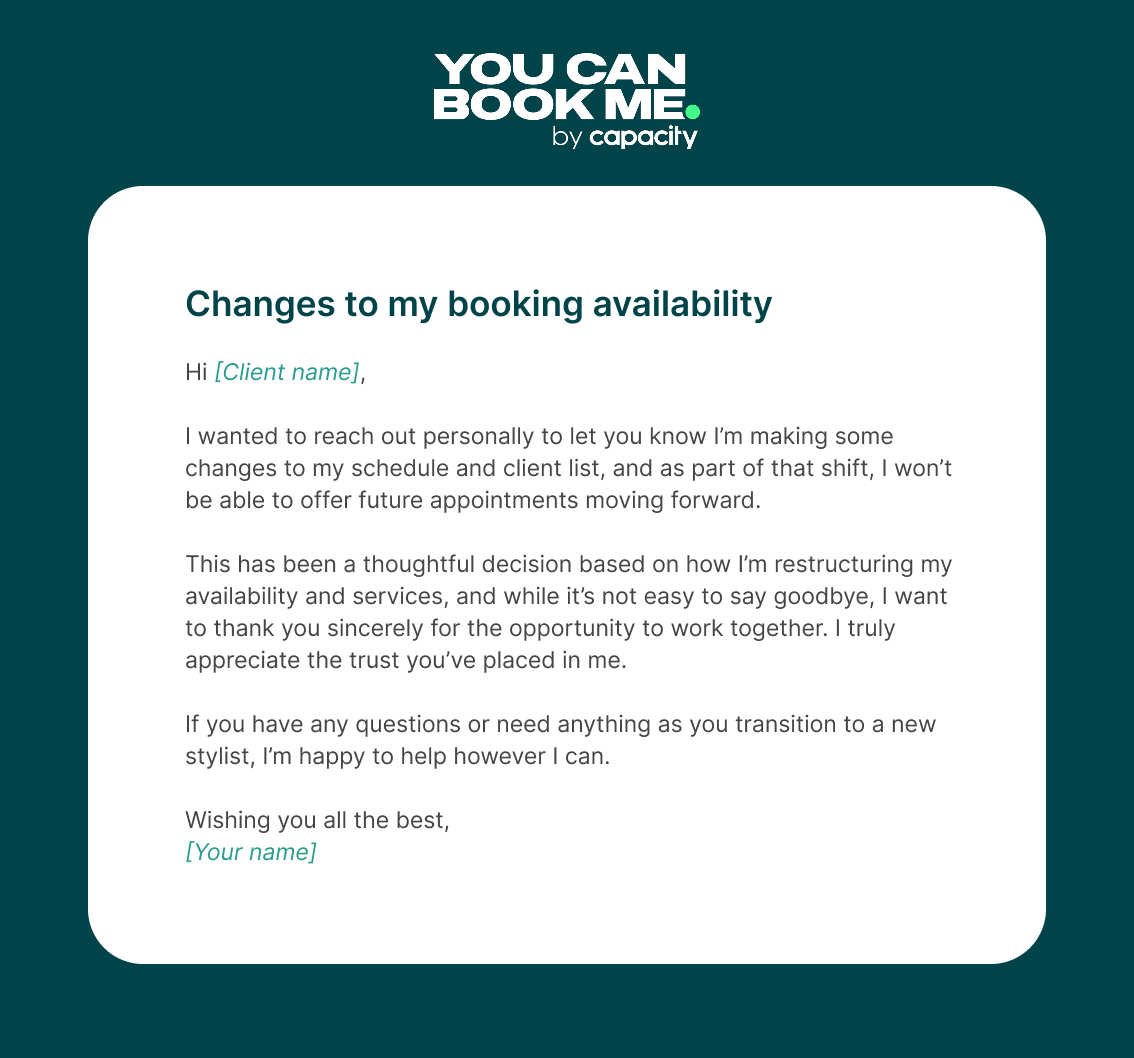
Lawyer/legal professional
Subject: Transition in legal representation
Hello [Client name],
I want to thank you for the opportunity to represent you over the past [length of time]. It’s been a privilege to support you through [case type or general reference], and I truly value the trust you placed in me.
After reviewing my current caseload and professional commitments, I’ve determined that I’m no longer in a position to continue representing you. This decision was made with careful thought, and it’s based solely on my current capacity—not the importance of your case.
I’ll make sure all outstanding matters are wrapped up and any necessary files or documentation are handed off to you by [date], or to another attorney of your choosing. If you'd like, I’m happy to recommend a few trusted colleagues who may be able to assist you going forward.
Again, I truly appreciate the opportunity to have worked with you and wish you all the best in the future.
Sincerely,
[Your name]
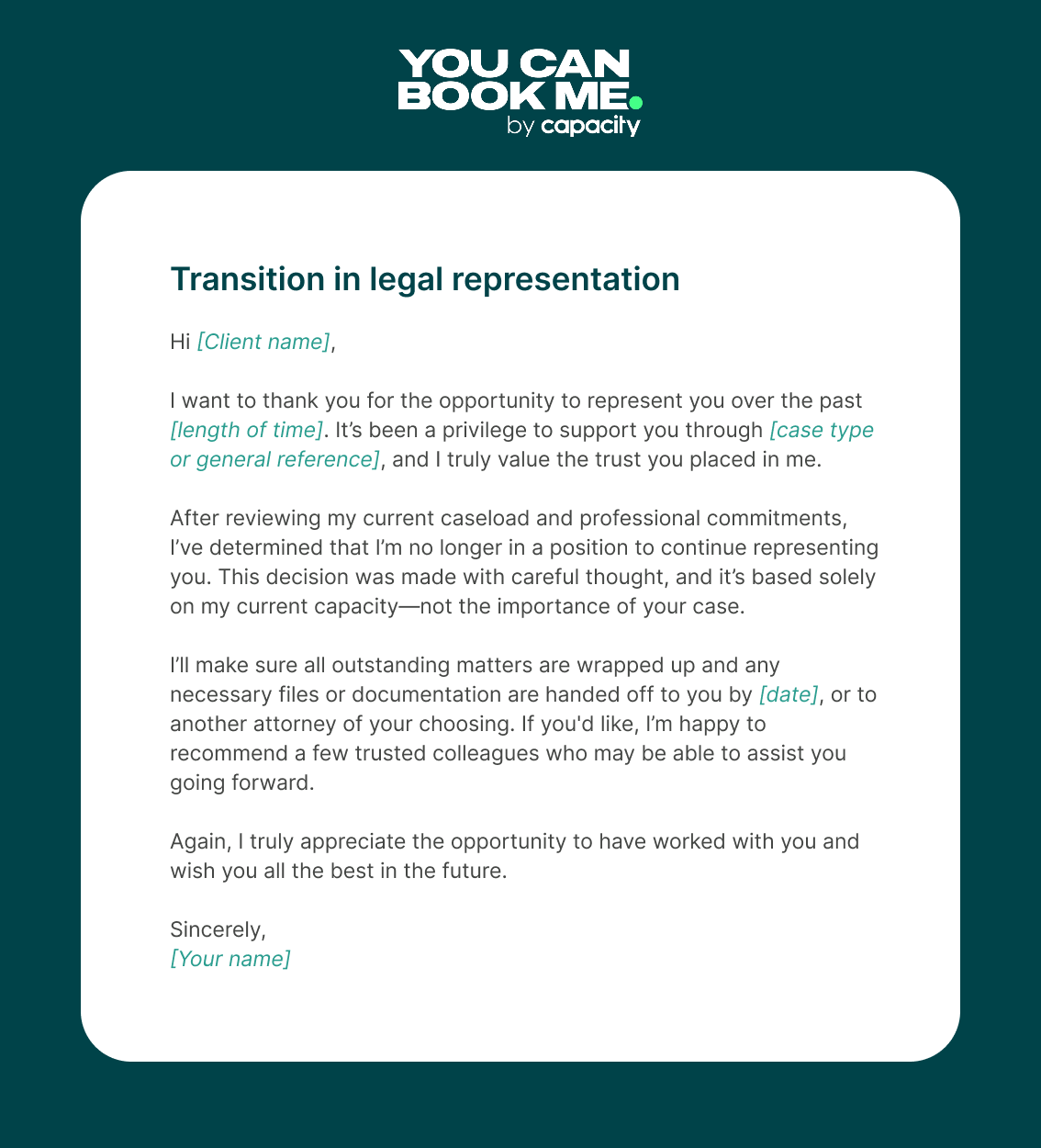
Independent consultant/freelancer
Subject: Wrapping up our project
Hi [Client name],
I’ve really appreciated the chance to work with you on [project or service]—thank you again for the collaboration and trust. After taking a close look at my current priorities and bandwidth, I’ve decided it’s best for me to step away from our work together.
That said, I’m committed to making this transition as smooth as possible. I’ll complete and deliver all outstanding work by [date], and I’m happy to share any documentation, assets, or context that will help you move forward. If it’s helpful, I can also recommend someone from my network who may be a great fit for what’s next.
Wishing you all the best as you continue with the project, and thank you again for the opportunity to contribute.
All the best,
[Your name]
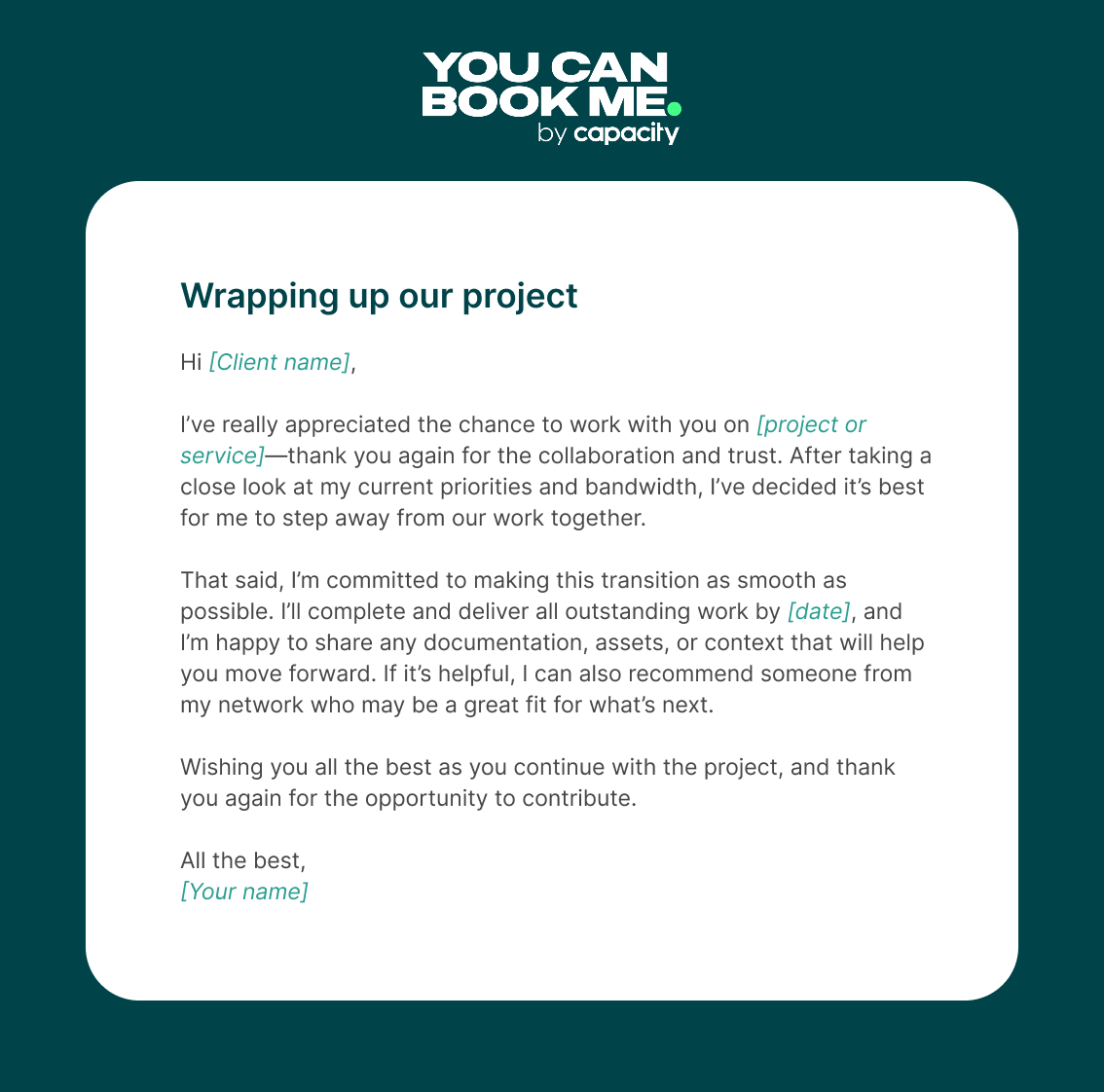
What not to do when firing a client
Firing a client is delicate, and the way you do it can impact your credibility, referrals, and confidence. It really is a small world, and word can travel fast. That’s why keeping things as positive (or at least neutral) as possible isn’t just good etiquette—it’s smart business.
Here’s what to avoid if you want to keep things professional and protect your reputation long term:
❌ Don’t ghost them
Disappearing without explanation may seem like the path of least resistance (especially if emotions are high), but it’s deeply unprofessional. Ghosting leaves the client confused, frustrated, and with zero closure. Even if the relationship has gone south, take the time to send a brief, respectful message to officially close things out.
❌ Don’t blame them (even if they’re the reason)
It can be tempting to list out every reason why the relationship didn’t work, but this often makes things worse. Assigning blame can trigger defensiveness, hurt feelings, or even online backlash. Keep the focus on the misalignment or your business direction—not their shortcomings. You can be honest without being accusatory!
Never put it on the client. ‘I am not our best fit for you. There may be people I can recommend.’ Or, if you don’t want to be so connected to the client, you can say, ‘I wish you all the best. I’m basically not the person for you.”
- Corine La Font, Public Relations and Communication Consultant
❌ Don’t vent on social media
Ranting about a difficult client online might feel cathartic in the moment, but it reflects poorly on you, not them. Even vague subtweets can backfire, especially in small industries or communities.
❌ Don’t cut them off mid-project (unless absolutely necessary!)
Ending things abruptly halfway through a deliverable or milestone can create confusion and damage your credibility. Unless the situation is abusive, unethical, or non-payable, do your best to finish what you promised—or offer a clear handoff.
❌ Don’t ignore the lessons
It’s easy to say “good riddance” and move on—but these situations are rich with insight. Every tough client is an opportunity to refine your red flags, processes, contracts, or boundaries (more on this below!).
Life after firing a client
You’ve let the client go. Deep breath. Now what? Here's to recovering, rebuilding, and getting yourself in an even better position moving forward. 💃
✅ Revisit your budget and revenue forecast
Make sure you’re clear on the financial impact of letting the client go. Can you cover the gap? Do you need to pick up a new client quickly, or do you have breathing room?
Next steps? Review your cash flow and pipeline. If your income’s taken a hit, prioritize outreach to warm leads or past clients who were a better fit.
✅ Reflect on what didn’t work
Take time to reflect on why the relationship fell apart. Was it poor communication? Mismatched expectations? A service you no longer enjoy offering? This is gold for refining your ideal client profile.
Our advice? After the dust settles, jot down what you learned, and reflect on a few questions like: “Were there early red flags I ignored? What would I do differently next time?” It’ll save you from repeating the same situation again!
✅ Strengthen your client screening process
One of the best ways to avoid difficult client relationships in the future? Stop them before they start! That means putting a stronger filter in place during your intake or booking process—so you’re only booking discovery calls with people who are a true fit for your services, style, and values.
If you use a scheduling tool like YouCanBookMe, you can input lead qualification questions right into your booking form, to ask clients important details like:
- What is your estimated budget for this product/service?
- How do you prefer to communicate—email, calls, or async tools?
- What’s your ideal start date and timeline for this project?
- What does a successful outcome look like to you?
- How involved do you want to be throughout the process?
These questions help you gauge not just what a client needs, but how they work—and whether that lines up with how you work. Start with 2–3 must-have questions, and see how they work for you. Remember, the goal is to qualify without overwhelming!
✅ Update your boundaries, contracts, or scope documents
Did the client constantly message you after hours? Or expect unlimited revisions? Use this moment to reinforce your processes so future clients know exactly what to expect—and what’s not included.
This might mean:
- Setting a clear limit on the number of revisions
- Defining your response times and preferred communication channels
- Outlining your working hours and availability
- Adding late payment terms or penalties
- Creating a simple onboarding email or PDF that clearly sets expectations from the start
Walking away, the right way
Firing a client isn’t easy—but it’s sometimes the healthiest move you can make for your business. When you handle it professionally, you protect your time, your energy, and your reputation.
The key? Know when to walk away, prepare thoughtfully, and set yourself up for better-fit clients in the future.
That’s where YouCanBookMe can make a real difference. With smart booking forms and request-only bookings, you can screen out mismatches before they take up your time—so your calendar fills up with people who actually get you, your process, and your value.
Give it a try (it’s free!) and start booking clients who feel like a good fit from day one.
FAQs
1. What should I say when firing a client?
Keep it short, professional, and kind. You don’t need to justify every detail—just be clear about your decision and respectful in your tone. Focus on misalignment, not blame.
Example: "Thanks so much for the opportunity to work together. After reviewing my current workload and priorities, I’ve decided I’m no longer the right fit for your project. I’ll wrap up any outstanding work by [date] and am happy to help with a smooth handoff."
2. Is it OK to fire a client over email?
The answer is—it depends! If your relationship is mostly transactional or short-term, an email could be the right choice. Email gives you space to communicate clearly and creates a written record of the conversation.
That said, if the client is long-standing or if you’ve had strong rapport, consider sending a heads-up via email and offering to discuss it live. For example: "I’d be happy to talk this through on a call if you prefer—just let me know what works for you."
Bottom line: Choose the method that feels most respectful to the relationship and most comfortable for you.
3. How much notice should I give when ending a client relationship?
It depends on your contract and the scope of work. If there's no formal agreement, a 1–2 week notice is often fair. For larger or ongoing projects, 30 days may be more appropriate.
Review your contract (if you have one) and align your notice period with what you committed to. And if you don’t have a contract, this is a great time to start using one for future clients! Also, whenever possible, offer to wrap up or hand off open work. It shows professionalism and protects your reputation.
4. Can I fire a client mid-project?
Yes, but be mindful of the timing and consequences. If you’re in the middle of a major deliverable or milestone, try to finish that phase or offer a clear path to transition. However, if the client is abusive, violating your boundaries, or not paying, you have every right to walk away—even mid-project.
If it’s urgent: "Due to ongoing challenges and lack of payment, I’m no longer able to continue work on this project. I’ll be closing things out as of [date]."
Otherwise, try to reach a logical stopping point and send over files, documentation, or a referral if possible.
5. How do I avoid bad clients in the future?
It starts with prevention, not just reaction. Set expectations early, filter out mismatches during your intake process, and get comfortable saying no.
Here’s what helps:
- Use lead qualification questions in your booking form (budget, timeline, goals, communication style)
- Send a welcome email or onboarding doc that outlines how you work
- Include clear boundaries in your contract (working hours, revision limits, response times)
- Trust your gut—if something feels off during your discovery call, it probably is!
Bonus tip: Create a “red flag” list for yourself based on past experiences, so you spot issues before they become problems.
Subscribe to our newsletter
Get productivity tips, news, articles and resources.-min.png)
Written by
Gabriela Łaba
Gabriela is an (everything bagel) seasoned copywriter who has been banging out copy for brands both big and small since 2016. In her free time, you can find her buying Halloween decorations, reading, and trying to force her cat to love her.



